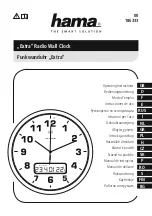
Exalt Communications Inc.
EX-2.4i Installation and Maintenance Manual
Page 22
MAN-002400, Revision 001
2005-12-01
connectors. For waveguide, the waveguide flange can typically accommodate a direct adapter to
an N connector, or alternatively, the antenna can be purchased with a direct waveguide
connection. But often a flexible coaxial jumper is needed to connect between the waveguide to
the antenna, as waveguide is generally inflexible and can be mechanically challenging to align to
the exact antenna connector location.
If possible, connect the primary transmission line directly to the antenna. It is desired to have the
fewest possible pieces of transmission line in the system, to minimize losses and points of failure
from connectors, and the antenna can typically accommodate a direct connection if planned in
advance. You may use a 90-degree adaptor for the connection to the antenna, if necessary – but
be certain to confirm that all connectors and transmission lines are properly specified for the
operating frequency (2400 to 2483.5MHz, in this case) with minimum loss, proper impedance
(50 ohm) and proper Voltage Standing Wave Ratio (VSWR) characteristics.
Transmission line connector termination is perhaps the most critical element of the installation.
Many ‘factory built’ RF transmission lines may actually not provide the proper characteristics
for proper transmission, despite their published specifications, often due to the fully- or semi-
automated process of factory termination, which may not have considered the frequency of your
system. When buying pre-terminated transmission line, it is strongly advised to receive
documentation of the test measurements on the connected transmission line showing that the loss
characteristics and VSWR are within specified limits specifically at your operating frequency. In
addition to factory-built transmission line, self-terminated transmission line can suffer the same
issues. Always follow the manufacturer’s termination process EXACTLY, and only use the
manufacturer’s authorized tools and connectors for a given transmission line type. The
manufacturer’s of transmission line typically offer instruction and certification for transmission
line termination, and may also provide videos illustrating the process. There is no amount of
extra care, education, precision and effort that can be overstated for this process.
Once the transmission line is connected to the antenna, traverse the exact route provided by the
site planner. There is often a need for a small excess of transmission line near the antenna to
accommodate both the need for extra slack as the antenna is loosened and moved for the
alignment process, as well as to accommodate a drip loop for the transmission line, and the initial
transmission line securing hardware and grounding near the antenna. In addition, the
transmission line is typically very stiff, and can provide undue pulling force on the antenna
connector. Take care to align the cable with the connector in a manner that does not provide any
torque or strain on the connector.
Consult your transmission line manufacturer for proper transportation, hoisting, securing and
grounding process. Always be very mindful to the entire length of transmission line to assure that
the transmission line is never twisted or kinked or over-bent past the specified bend radius. Once
a transmission line is over-bent, it may never recover its specified characteristics, even after
straightening.
The opposite end of this primary transmission line will typically terminate at the building or
enclosure egress point. This is the location where the RF lightning arrestor shall be located. A
proper termination to the connector-type of the lightning arrestor shall be made at this location.
















































